Opel Insignia
The Opel Insignia is a mid size/large family car engineered and produced by the German car manufacturer Opel, currently in its second generation. Production of the Insignia began in August 2008, as a replacement for the Vectra and Signum.[1] The vehicle is sold under the Vauxhall marque in the United Kingdom, in Australia as the Holden Commodore, and sold in North America and China as the Buick Regal.[2][3]
| Opel Insignia | |
|---|---|
_%E2%80%93_Frontansicht%252C_12._Mai_2017%252C_D%C3%BCsseldorf.jpg.webp) | |
| Overview | |
| Manufacturer | Opel (Groupe PSA under license by General Motors) |
| Also called |
|
| Production | 2008–present |
| Designer | Mark Adams Malcolm Ward |
| Body and chassis | |
| Class | Large family car (D) |
| Layout | FF or F4 layout |
| Chronology | |
| Predecessor | |
In Chile, the vehicle was originally due to be marketed as the Chevrolet Vectra,[4] but went on sale as the Opel Insignia instead.[5]
The Insignia made its debut in Australia in August 2012, badged as an Opel,[6] but was dropped one year later after the brand was withdrawn from the market.[7] The first generation Insignia was again launched in Australia (and New Zealand for the first time) under the Holden marque in 2015. From February 2018, the second generation Insignia was sold under the name of the Commodore (ZB) until 2020, when it was discontinued.
The Insignia is produced in Opel's plant in Rüsselsheim, Germany.
History
In December 2006, What Car? announced that Vauxhall was to ditch the Vectra nameplate from the previous model. Then General Motors Europe president, Carl-Peter Forster, leaked the news to BusinessCar, explaining that the all new car would be "a radical departure" from the current model, and that the "Vectra" name would be dropped to reflect this change.[8]
In March 2007, What Car? reported the car would première at the 2008 British International Motor Show. Previously, it was thought it would première at the 2008 Geneva Motor Show.[9] In October 2005, Auto Express produced computer generated images, which showed an unused design.
In September 2007, What Car? produced computer generated images, showing what the replacement would look like.[10] That month, What Car? gave an update, confirming the car would première in London, thanks to the success of the Corsa C.[11] In November 2007, What Car? announced that Vauxhall had confirmed that the successor's name would be Insignia.[12]
First generation (G09; 2008)
| Opel Insignia A / Mk I (G09) | |
|---|---|
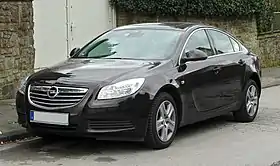 | |
| Overview | |
| Also called |
|
| Production | 2008–2017 |
| Assembly |
|
| Designer |
|
| Body and chassis | |
| Body style | 4-door saloon / fastback 5-door estate |
| Platform | GM Epsilon II SWB |
| Related | Chevrolet Malibu |
| Powertrain | |
| Engine |
|
| Transmission | 6-speed manual 6-speed automatic |
| Dimensions | |
| Wheelbase | 2,737 mm (107.8 in) |
| Length | 4,830 mm (190.2 in) 4,908 mm (193.2 in) (wagon) |
| Width | 1,856 mm (73.1 in) |
| Height | 1,498 mm (59.0 in) |
| Curb weight | 1,470–1,610 kg (3,240–3,550 lb) |
The Insignia debuted at the 2008 British International Motor Show in London on 23 July as the Opel/Vauxhall Insignia. This reflected the Vauxhall brand that is unique to the United Kingdom.[15] It then went on sale in European dealerships in October 2008 as a four-door fastback / saloon, and five door estate, dubbed Sports Tourer – a departure for Opel which traditionally used the "Caravan" name to denote the estate bodystyle.
The Insignia was the first production car to be based on the Epsilon II platform, which was also used on other models such as the 2010 Saab 9-5 and the Chevrolet Malibu.
The Insignia was the first car to debut new badges for both the Opel and Vauxhall brands, and for Vauxhall, it was the first car to dispense with the characteristic "V" grille that has adorned Vauxhall models since 1994, which differentiated them from the otherwise identical Opel models.
The Insignia was also the first Opel to debut many new and improved safety features, including:
- (an improved) Adaptive Forward Lighting – bi-xenon, gas discharge headlamps with variable light beam distribution in width, direction and range. Advanced Front-Lighting System (AFS), static cornering light, complemented by daytime running lights with LEDs. Sensors and software monitor the surroundings, traffic and weather conditions so that the system can activate the appropriate lighting function.
- Opel Eye – This uses a camera at the top of the windscreen to monitor the area in front of the vehicle. Information from the camera is continuously analysed to identify road markings and traffic signs. Road markings are used as the basis of the first of Opel Eye's two functions: lane departure warning. Traffic signs are recognised and indicated to the driver in the second function: traffic sign memory.
At speeds above 60 km/h (37 mph), Opel Eye warns the driver if the car is about to veer inadvertently out of the lane in which it is travelling. The system can detect road markings and, if they are sufficiently distinct, unmarked road edges. The Insignia was the first production car to feature a dual function frontal camera with traffic sign recognition.
Despite its global presence, the Opel Insignia has never been sold in Japan, as Opel had already withdrawn from the market in Japan before launching this model.
Design wise, the Insignia offers 30 mm (1.2 in) more knee room than the Vectra. The saloon and fastback variants have the same 4.83 m (190.2 in) length and wheelbase of 2.73 m (107.5 in). The estate version is slightly longer at 4.91 m (193.3 in) on the same wheelbase.
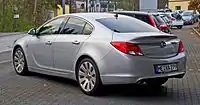 Opel Insignia saloon (2008–2013)
Opel Insignia saloon (2008–2013)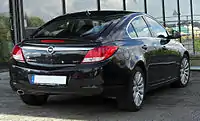 Opel Insignia fastback (2008–2013)
Opel Insignia fastback (2008–2013)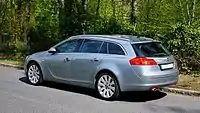 Opel Insignia Sports Tourer (2008–2013)
Opel Insignia Sports Tourer (2008–2013) Vauxhall Insignia (Britain; pre facelift)
Vauxhall Insignia (Britain; pre facelift)_VXR_sedan_(20104110092).jpg.webp) Holden Insignia VXR (Australia)
Holden Insignia VXR (Australia)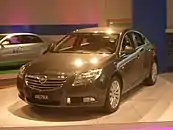 Chevrolet Vectra
Chevrolet Vectra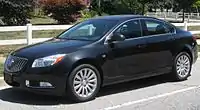 Buick Regal (North America)
Buick Regal (North America) Interior
Interior
OPC
In the beginning of 2009, Opel revealed the Insignia OPC, a high performance variant of the Insignia.[16] Like the preceding Vectra OPC, it is powered by a 2.8 litre turbocharged V6 (Manufactured in Melbourne, Australia).[16][17]
The updated engine makes 239 kW (325 PS; 321 hp) and 435 N⋅m (321 lb⋅ft). Of this 435, 400 N⋅m (295 lb⋅ft) are available from 2,000 rpm.[18] It is paired with a six speed manual transmission / six-speed automatic transmission and Saab's (Haldex) active all wheel drive system. The Insignia OPC has a modified MacPherson strut front suspension called HiPerStrut which reduces torque steer.
Also standard is an electronic limited slip differential for the rear wheels and Opel's FlexRide adaptive suspension, which has three settings (OPC, Sport, and Normal). An OPC version of the Insignia Sports Tourer wagon has also been unveiled and is currently on sale. In April 2011, Opel launched the Insignia OPC Unlimited, with no speed limiter.[19]
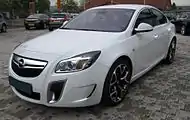 Opel Insignia OPC
Opel Insignia OPC.jpg.webp) Opel Insignia OPC
Opel Insignia OPC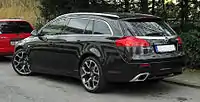 Opel Insignia OPC Sports Tourer
Opel Insignia OPC Sports Tourer.jpg.webp) Opel Insignia OPC (facelift)
Opel Insignia OPC (facelift)
Country Tourer
The Opel Insignia Country Tourer made its world premiere at the Frankfurt Motor Show in September 2013 as a crossover-styled station wagon.
_%E2%80%93_Frontansicht%252C_24._Oktober_2015%252C_M%C3%BCnster.jpg.webp) Opel Insignia Country Tourer
Opel Insignia Country Tourer_%E2%80%93_Heckansicht%252C_24._Oktober_2015%252C_M%C3%BCnster.jpg.webp) Opel Insignia Country Tourer
Opel Insignia Country Tourer
Facelift
A major facelift was introduced in June 2013, with new exterior and interior styling, new engines, and new safety features. The car officially premiered at the September 2013 Frankfurt Motor Show, before going on sale later in 2013.
The new design includes a newly designed cockpit with a simplified control panel and two eight inch colour displays, a four way infotainment system via new a touchpad in the centre console, an eight-inch touchscreen, steering wheel controls, voice command, radar and camera based driver assistance and safety systems, such as full speed adaptive cruise control and imminent collision braking, rear camera, lane change assistance, blind spot alert, and rear cross traffic alert.
The second generation Insignia was revealed in December 2016, and was reported to be renamed Insignia Grand Sport.
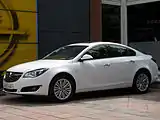 Opel Insignia 2.0 Turbo (Chile)
Opel Insignia 2.0 Turbo (Chile)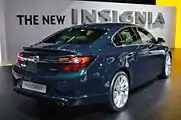 Opel Insignia
Opel Insignia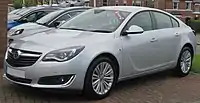 Vauxhall Insignia (facelift)
Vauxhall Insignia (facelift)
2008–2013
From launch, the Insignia was offered with four petrol engines – a 1.6 L 115 PS (85 kW; 113 hp), 1.8 L 140 PS (103 kW; 138 hp), 2.0 L Turbo 220 PS (162 kW; 217 hp), and a 2.8 L V6 with 260 PS (191 kW; 256 hp) – and three diesel engines (all derived from the Fiat/GM JTD engine) – all 2.0 litres with 110 PS (81 kW; 108 hp), 130 PS (96 kW; 128 hp) and 160 PS (118 kW; 158 hp). In 2009, a 1.6 L Turbo petrol 180 PS (132 kW; 178 hp), the ecoFLEX diesels, and the OPC versions were introduced.
From September 2010, the 2.0 CDTi diesel engine gained Adaptive 4x4 as an option. A '2.0 BiTurbo' CDTI, with 195 PS (143 kW; 192 hp), in development with Saab, was expected to begin production in 2010, but due to the sale of Saab, production was delayed and began production in 2012, as 2WD (FWD) and 4WD. All engines have a six speed manual transmission as standard, with some engines having an automatic transmission as an option.
Since launch, all diesels have improved their emissions. In 2011, some engines gained Start/Stop, all diesel engines have this option, with more petrol engines expected to gain the technology in the future. A 1.4 Turbo 140 PS (103 kW; 138 hp), with S/S as standard, is available, replacing the 1.8, and the 2.0 Turbo was upgraded to 250 PS (184 kW; 247 hp) only with four wheel drive. The 2.0 Turbo with 220 PS (162 kW; 217 hp) remains as only FWD.
In 2009, a new range of ecoFLEX diesel engine offered same amount of power, but less CO2-emission (g/km) and fuel consumption. The 2.0 CDTI ecoFLEX with 130 PS (96 kW; 128 hp) and 160 PS (118 kW; 158 hp) have emission of only 114 CO2-emission (g/km), as well as a version with 2.0 CDTI 4x4. The 195 PS (143 kW; 192 hp) Bi turbo diesel engine has 129 CO2-emission (g/km).
| Petrol engine | |||||||||
|---|---|---|---|---|---|---|---|---|---|
| Model | Engine | Displacement | Power | Torque | Note | Year | |||
| 1.4 Turbo S/S | I4 | 1,364 cc | 140 PS (103 kW; 138 hp) @4,900–6000 rpm | 200 N⋅m (148 lb⋅ft) @1850-4,900 rpm | 2011–13 | ||||
| 1.6 VVT | I4 | 1,598 cc | 115 PS (85 kW; 113 hp) @6,000 rpm | 155 N⋅m (114 lb⋅ft) @4,000 rpm | 2008–12 | ||||
| 1.6 Turbo | I4 | 1,598 cc | 180 PS (132 kW; 178 hp) @5,500 rpm | 230 N⋅m (170 lb⋅ft) @2,200–5,500 rpm | |||||
| 1.8 VVT | I4 | 1,796 cc | 140 PS (103 kW; 138 hp) @6,300 rpm | 175 N⋅m (129 lb⋅ft) @3,800 rpm | |||||
| 2.0 Turbo | I4 | 1,998 cc | 220 PS (162 kW; 217 hp) @5,300 rpm | 350 N⋅m (258 lb⋅ft) @2,000-4000 rpm | 2008–13 | ||||
| 2.0 Turbo 4x4 | I4 | 1,998 cc | 220 PS (162 kW; 217 hp) @5,300 rpm | 350 N⋅m (258 lb⋅ft) @2,000-4000 rpm | 2008–11 | ||||
| 2.0 Turbo 4x4 | I4 | 1,998 cc | 250 PS (184 kW; 247 hp) @5,300 rpm | 400 N⋅m (295 lb⋅ft) @2,400–3,600 rpm | 2011–13 | ||||
| 2.8T 4x4 | V6 | 2,792 cc | 260 PS (191 kW; 256 hp) @5,500 rpm | 350 N⋅m (258 lb⋅ft) @1,900–4500 rpm | 2008–13 | ||||
| 2.8T 4x4 | V6 | 2,792 cc | 325 PS (239 kW; 321 hp) @5,500 rpm | 435 N⋅m (321 lb⋅ft) @5,500 rpm | OPC/VXR | 2009–13 | |||
| Diesel engine | |||||||||
| Model | Engine | Displacement | Power | Torque | Note | Year | |||
| 2.0 CDTI | I4 | 1,956 cc | 110 PS (81 kW; 108 hp) @4,000 rpm | 260 N⋅m (192 lb⋅ft) @1,750–2500 rpm | N/A in UK | ||||
| 2.0 CDTI | I4 | 1,956 cc | 130 PS (96 kW; 128 hp) @4,000 rpm | 300 N⋅m (221 lb⋅ft) @1,750–2500 rpm | |||||
| 2.0 CDTI | I4 | 1,956 cc | 160 PS (118 kW; 158 hp) @4,000 rpm | 350 N⋅m (258 lb⋅ft) @1,750–2500 rpm | |||||
| 2.0 CDTI 4x4 | I4 | 1,956 cc | 160 PS (118 kW; 158 hp) @4,000 rpm | 350 N⋅m (258 lb⋅ft) @1,750–2500 rpm | 2010–13 | ||||
| 2.0 CDTI Bi-Turbo | I4 | 1,956 cc | 195 PS (143 kW; 192 hp)@4,000 rpm | 400 N⋅m (295 lb⋅ft) @1,750–2500 rpm | 2012–13 | ||||
| 2.0 CDTI Bi-Turbo 4x4 | I4 | 1,956 cc | 195 PS (143 kW; 192 hp)@4,000 rpm | 400 N⋅m (295 lb⋅ft) @1,750–2500 rpm | 2012–13 | ||||
2013–2017
Alongside the facelift of 2013 came a new range of engines – some existing, some tweaked, and some brand new. Diesel engines available at launch include the 2.0 CDTI ecoFLEX (also with Start/Stop), with outputs of 120 PS, 140 PS, and 163 PS and the existing 195 PS BiTurbo. There is also a non ecoFLEX engine with 130 PS which is only available with automatic transmission.
Petrol engines include the existing 1.4 Turbo and 1.8 (only on some markets), and the all new 1.6 SIDI Turbo engine introduced in the Cascada, and new 2.0 SIDI Turbo.
All engines come with a six speed manual gearbox as standard, with a six speed automatic available as an option on the 1.6 and 2.0 SIDI turbo petrol engines, and the 2.0 CDTI 163 PS and 195 PS diesel engines. All petrol and diesel engines have a Start/Stop system except the 2.0 CDTI with 130 PS.
In September 2014, Opel introduced its all new generation of engines – large diesel engine, starting with 2.0 CDTI engine with 170 PS and 400 Nm, which is a part of new strategy in which Opel will introduce 17 new engines in a period from 2014 to 2018. The new engine became available from the end of 2014/beginning of 2015.[20]
| Petrol engine | |||||||||
|---|---|---|---|---|---|---|---|---|---|
| Model | Engine | Displacement | Power | Torque | Note | CO2 (g/km) | Year | ||
| 1.4 Turbo S/S | I4 | 1,362 cc | 140 PS (103 kW; 138 hp) @4,900–6000 rpm | 200 N⋅m (148 lb⋅ft) @1850-4,900 rpm | 123 | ||||
| 1.6 SIDI Turbo S/S | I4 | 1,598 cc | 170 PS (125 kW; 168 hp) @4,250 rpm | 260 N⋅m (192 lb⋅ft) (overboost 280 N⋅m (207 lb⋅ft)) @1,650–4,250 rpm | 139 | ||||
| 1.8 VVT | I4 | 1,796 cc | 140 PS (103 kW; 138 hp) @6,300 rpm | 175 N⋅m (129 lb⋅ft) @3,800 rpm | 164 | ||||
| 2.0 SIDI Turbo S/S | I4 | 1,998 cc | 250 PS (184 kW; 247 hp) @4,500 rpm | 400 N⋅m (295 lb⋅ft) @2,000–4,500 rpm | 169 | ||||
| Diesel engine | |||||||||
| Model | Engine | Displacement | Power | Torque | Note | CO2 (g/km) | Year | ||
| 1.6 CDTI | I4 | 1,598 cc | 120 PS (88 kW; 118 hp) @4,000 rpm | 320 N⋅m (236 lb⋅ft) @2,000 rpm | 109-104 | 2015–17 | |||
| 1.6 CDTI | I4 | 1,598 cc | 136 PS (100 kW; 134 hp) @4,000 rpm | 320 N⋅m (236 lb⋅ft) @2,000 rpm | 104-99 | 2015–17 | |||
| 2.0 CDTI ecoFLEX S/S | I4 | 1,956 cc | 120 PS (88 kW; 118 hp) @4,000 rpm | 300 N⋅m (221 lb⋅ft) (overboost 320 N⋅m (236 lb⋅ft)) @1,750–2,500 rpm | 99 | 2013–15 | |||
| 2.0 CDTI | I4 | 1,956 cc | 130 PS (96 kW; 128 hp) @4,000 rpm | 300 N⋅m (221 lb⋅ft) (overboost 320 N⋅m (236 lb⋅ft)) @1,750–2,500 rpm | Only with AT | 119 | 2013–15 | ||
| 2.0 CDTI ecoFLEX S/S | I4 | 1,956 cc | 140 PS (103 kW; 138 hp) @4,000 rpm | 350 N⋅m (258 lb⋅ft) (overboost 370 N⋅m (273 lb⋅ft)) @1,750–2,500 rpm | 99 | 2013–15 | |||
| 2.0 CDTI ecoFLEX S/S | I4 | 1,956 cc | 163 PS (120 kW; 161 hp) @4,000 rpm | 350 N⋅m (258 lb⋅ft) (overboost 380 N⋅m (280 lb⋅ft)) @1,750–2,500 rpm | 114 | 2013–15 | |||
| 2.0 CDTI ecoFLEX S/S | I4 | 1,956 cc | 170 PS (125 kW; 168 hp) @4,000 rpm | 400 N⋅m (295 lb⋅ft) @1,750–2,500 rpm | 114 | 2014–17 | |||
| 2.0 CDTI Bi-Turbo ecoFLEX S/S | I4 | 1,956 cc | 195 PS (143 kW; 192 hp)@4,000 rpm | 400 N⋅m (295 lb⋅ft) @1,750–2,500 rpm | 125 | 2013–15 | |||
Awards
Since making its début, the Opel Insignia has won more than fifty national and international awards, including 'Best Executive Car' in the United Kingdom and Slovenia, 'Best Family Car' in Ireland twice, and best car for fleet customers in the United Kingdom, Austria, Denmark, and Portugal.[21]
- The Insignia was voted 2009 European Car of the Year.[22][23]
- The Insignia scored a five star rating in EuroNCAP.
- In 2011, German institute DEKRA gave Opel an award for the Insignia as a car with the fewest flaws in its class.[24]
- In 2012, Gesellschaft für Technische Überwachung mbH/Association for Technical Supervision evaluated Opel Insignia as number one in terms of used car quality.[25]
Production and sales
Production started at the end of 2008 on all major markets in Europe. At launch, the Vauxhall versions were produced in Exclusiv, S, SE, SRi, Elite, and VXR specification levels. It was a popular choice with British buyers, being the nation's ninth best selling car in 2009 – its first full year on sale, outselling its direct competitor the Ford Mondeo, but just falling short of the sales achieved by the more upmarket BMW 3 Series.[26]
At the beginning several trim levels were available, depending on the market: Essentia, Edition, Sport, Cosmo, OPC. Later on others were added, such as the Business edition, Selection, Active, 150 years of Opel, and Innovation.
By August 2011, over 400,000 Insignias had been sold, and on 26 April 2012, the 500,000th Insignia was produced.[27] The last vehicle rolled off the line in April 2017, in time for the release of the Insignia II.
Second generation (Z18; 2017)
| Opel Insignia B / MkII (Z18) | |
|---|---|
_%E2%80%93_Frontansicht%252C_5._Mai_2017%252C_D%C3%BCsseldorf.jpg.webp) | |
| Overview | |
| Also called | Vauxhall Insignia (United Kingdom) Buick Regal (North America and China) Holden Commodore (ZB) (Australia & New Zealand) |
| Production | 2017–present |
| Model years | 2017–2020 (North America & Oceania) |
| Assembly | Germany: Rüsselsheim China: Shanghai (SAIC-GM) (Buick Regal) |
| Designer | Mark Adams Malcolm Ward[13][14] |
| Body and chassis | |
| Body style | 5-door fastback 5-door estate |
| Platform | E2XX platform |
| Related | Chevrolet Malibu Cadillac XT4 |
| Powertrain | |
| Engine | Petrol 1.5 L ECOTEC I4-T 1.5 L LFV I4-T 2.0 L LTG I4-T 3.6 L LGX V6 Diesel 1.6 L CDTI Ecotec I4-T 2.0 L CDTI Ecotec I4-T |
| Transmission | |
| Dimensions | |
| Wheelbase | 2,829 mm (111.4 in) |
| Length | 4,897 mm (192.8 in) 4,986 mm (196.3 in) (wagon) |
| Width | 1,863 mm (73.3 in) |
| Height | 1,455 mm (57.3 in) |
| Curb weight | 1,440–1,649 kg (3,175–3,635 lb) |
The Insignia had its public debut at the International Motor Fair in Belgrade in March 2017. The design took design cues from the 2013 Opel Monza Concept. From this point, the traditional four door notchback saloon version was officially removed. The vehicle was officially revealed on 26 June 2017.
Opel dropped the OPC designation for its performance Insignia, instead reverting to their older GSi nameplate, last seen on the third generation Opel Vectra. The GSi nameplate also replaces VXR, on the version of Vauxhall of the Insignia. This version of the Insignia is badged as the ZB Holden Commodore in Australia, and as the sixth generation Buick Regal in the Americas and Asia.
_%E2%80%93_Heckansicht%252C_5._Mai_2017%252C_D%C3%BCsseldorf.jpg.webp) Grand Sport
Grand Sport_%E2%80%93_Heckansicht%252C_12._Mai_2017%252C_D%C3%BCsseldorf.jpg.webp) Sports Tourer
Sports Tourer Country Tourer
Country Tourer_(cropped).jpg.webp) Vauxhall Insignia
Vauxhall Insignia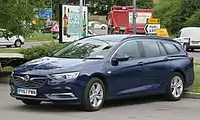 Vauxhall Insignia Sports Tourer
Vauxhall Insignia Sports Tourer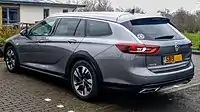 Vauxhall Insignia Country Tourer
Vauxhall Insignia Country Tourer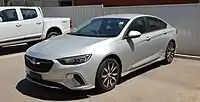 Holden Commodore (ZB)
Holden Commodore (ZB)_LT_Tourer_(2018-10-25).jpg.webp) Holden Commodore Sportwagon
Holden Commodore Sportwagon_V6_AWD_Tourer_(2018-11-29)_01.jpg.webp) Holden Commodore Calais Tourer
Holden Commodore Calais Tourer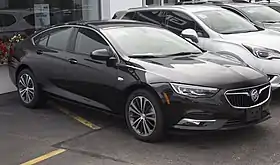 Buick Regal Sportback
Buick Regal Sportback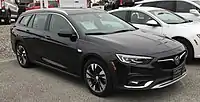 Buick Regal TourX
Buick Regal TourX
Engines
| Petrol engine | |||||||||
|---|---|---|---|---|---|---|---|---|---|
| Model | Engine | Displacement | Power | Torque | Note | CO2 (g/km) | Year | ||
| 1.5 SIDI Turbo S/S | I4 | 1.490 cc | 140 PS (103 kW; 138 hp) @ 5,600 rpm | 250 N⋅m (184 lb⋅ft) @ 2,000-4,500 rpm | 133 | 2017– | |||
| 1.5 SIDI Turbo S/S | I4 | 1.490 cc | 165 PS (121 kW; 163 hp) @ 5,600 rpm | 250 N⋅m (184 lb⋅ft) @ 2,000–4,500 rpm | 136 | 2017– | |||
| 2.0 SIDI Turbo S/S | I4 | 1,998 cc | 260 PS (191 kW; 256 hp) @ 5,300 rpm | 400 N⋅m (295 lb⋅ft) @ 2,500–4,000 rpm | Holden Commodores only boast 350Nm, in order to ensure V6 remains flagship engine | 197 | 2017– | ||
| 3.6 SIDI LGX | V6 | 3,564 cc | 320 PS (235 kW; 316 hp) @ 6,800 rpm | 381 N⋅m (281 lb⋅ft) @ 5,200 rpm | Will be available only on Holden Commodore (all versions) and Buick Regal GS | 215 | 2018– | ||
| Diesel engine | |||||||||
| Model | Engine | Displacement | Power | Torque | Note | CO2 (g/km) | Year | ||
| 1.6 CDTI S/S | I4 | 1,598 cc | 110 PS (81 kW; 108 hp) @ 3,500 rpm | 300 N⋅m (221 lb⋅ft) @ 1,750-2,000 rpm | 105 | 2017– | |||
| 1.6 CDTI S/S | I4 | 1.598 cc | 136 PS (100 kW; 134 hp) @ 3,500-4,000 rpm | 320 N⋅m (236 lb⋅ft) @ 2,000-2,250 rpm | 114 | 2017– | |||
| 2.0 CDTI S/S | I4 | 1,956 cc | 170 PS (125 kW; 168 hp) @ 3,750 rpm | 400 N⋅m (295 lb⋅ft) @ 1,750–2,500 rpm | 136 | 2017– | |||
| 2.0 CDTI BiTurbo S/S 4x4 | I4 | 1,956 cc | 210 PS (154 kW; 206 hp) @ 4,000 rpm | 480 N•m (354 lb•ft) @ TBC | 190 | 2017– | |||
Holden Commodore (ZB)
| Holden Commodore (ZB) | |
|---|---|
_LT_sedan_(2018-08-06)_01.jpg.webp) | |
| Overview | |
| Also called |
|
| Production | 2018–2020 |
| Assembly | Rüsselsheim, Germany (Opel Automobile GmbH) |
| Body and chassis | |
| Body style | 5-door liftback 5-door station wagon |
| Layout | FF/F4/FR (motorsport) |
| Platform | E2XX platform |
| Powertrain | |
| Engine | LTG 2.0L I4 turbo-petrol 2.0L Fiat Multijet II I4 turbo-diesel LGX 3.6L V6 petrol |
| Transmission | 8-speed automatic 9-speed automatic |
| Chronology | |
| Predecessor | Holden Malibu Holden Insignia (first generation) Holden Adventra (AWD Tourer) |
The Holden Commodore (ZB) is a large family car produced by former GM subsidiary Opel (at the time of its release was owned by Groupe PSA) in Rüsselsheim, Germany, released in February 2018. It is the first iteration of the fifth generation Holden Commodore platform, which is based on the second generation Opel Insignia. The range includes five door liftback sedan and five door station wagon bodystyles.
Holden previously sold the first generation Insignia under the Opel brand (Opel Insignia) in 2012 and 2013,[28] as well as under the Holden brand (Holden Insignia) from 2015 to 2017. It is the first Holden Commodore model to be manufactured outside of Australia, following the closure of Holden's Australian car manufacturing facilities at Elizabeth, South Australia and Fishermans Bend, Victoria on Friday 20 October 2017.
It is the first Commodore in thirty years to come with a four-cylinder engine as standard, and controversially, the first in its forty year production not to have a V8 powertrain option. Holden corporate made the decision to discontinue Australian manufacturing of the Holden Commodore due to falling sales and losses.
The ZB Commodore has proven to be unpopular resulting in cuts to the production plant[29] and the lowest months on record since the VB Commodore which was released in 1978.[30] November 2019 was the lowest month recorded with only 309 Commodores sold[31]
On 10 December 2019, it was announced that the ZB Commodore, and the Commodore nameplate, will be discontinued at the end of 2020, citing worsening sales.[32]
Development
Development for the ZB Commodore started in 2012, with Holden helping Opel design and develop the next generation Insignia, catering it to Australian conditions.
Once the car was ready, prototypes were sent to Australia for testing. Holden completed over 100,000 km of testing, with engineers bracing the cars to withstand local roads and make it feel similar to previous Commodore generations.[33]
Safety
Akin to its VF Commodore predecessor, the ZB achieved five stars in the ANCAP safety ratings. Originally, the ZB ANCAP rating was awarded based on the Euro NCAP test of a 1.6 litre model which is not sold in Australia.[34] ANCAP conducted an audit test on specification of Australia V6 and confirmed its rating.[35]
| ANCAP Test Results | |||
|---|---|---|---|
| Star rating: | |||
| Test[N 1] | Points | Out of | % |
| Adult Occupant Protection: | 35.34 | 38 | 93% |
| Child Occupant Protection: | 41.96 | 49 | 85% |
| Pedestrian Protection: | 32.83 | 42 | 78% |
| Safety Assist: | 9.35 | 12 | 77% |
Powertrains
The ZB Commodore is available with a range of engines including a four-cylinder petrol, four cylinder diesel and six-cylinder petrol engine. Front-wheel drive and all-wheel drive are available across the liftback and wagon body styles.
Models
Compared to the VF Commodore, Holden rearranged the specification levels with the only Calais variants surviving the cull, having been introduced with the VK Series of 1984 as the luxury focused models. Various price cuts were made and wagon variants are more expensive.
Commodore LT
_LT_Tourer_(2018-10-25).jpg.webp)
The LT is the new entry level Commodore, replacing the previous generation's Evoke model, which is also $3,935 cheaper than the predecessor's drive away price. It features a front wheel drive 2.0L Turbo four cylinder engine with a nine speed automatic, or an optional 2.0L diesel, with an eight speed automatic.
It comes with 17" alloy wheels, Autonomous Emergency Braking (AEB), Lane Keep Assist, a 7" MyLink system with Apple CarPlay & Android Auto and Passive Entry & Push Button Start as standard. The model is available as liftback or wagon.
| Model | Engine | Displacement | Power | Torque | Transmission | Pricing (Liftback) | Pricing (Sportswagon) |
|---|---|---|---|---|---|---|---|
| Petrol | I4 | 2.0L (1998cc) | 191 kW (256 hp; 260 PS) | 350 N⋅m (258 lb⋅ft) | 9 speed | $33,690 | $35,890 |
| Diesel | I4 | 2.0L (1956cc) | 125 kW (168 hp; 170 PS) | 400 N⋅m (295 lb⋅ft) | 8 speed | $36,690 | $38,690 |
Commodore RS The RS has a slightly sportier look than the LT model, with a sportier interior featuring sportier seats and steering wheel. It also features more safety features, including Blind Zone Alert and Rear Cross Traffic Alert. The RS has two drivetrain options of a front wheel drive 2.0L Turbo four cylinder engine, with a nine speed Automatic or an All Wheel Drive 3.6L V6 (only available on the Liftback). It comes with 18" alloy wheels. The model is available as liftback or wagon.
| Model | Engine | Displacement | Power | Torque | Transmission | Pricing (Liftback) | Pricing (Sportswagon) |
|---|---|---|---|---|---|---|---|
| Petrol | I4 | 2.0L (1998cc) | 191 kW (256 hp; 260 PS) | 350 N⋅m (258 lb⋅ft) | 9 speed | $37,290 | $39,490 |
| Petrol | V6 | 3.6L (3564cc) | 235 kW (315 hp; 320 PS) | 381 N⋅m (281 lb⋅ft) | 9 speed | $42,490 | N/A |
Commodore RS–V The RS–V is similar to the RS Model but includes more features such as an upgraded 8" MyLink system incorporating satellite navigation, wireless phone charging, Hi Per Strut Suspension and an Adaptive AWD system. Only the V6 AWD powertrain is offered in liftback and wagon forms.
| Model | Engine | Displacement | Power | Torque | Transmission | Pricing (Liftback) | Pricing (Sportswagon) |
|---|---|---|---|---|---|---|---|
| Petrol | V6 | 3.6L (3564cc) | 235 kW (315 hp; 320 PS) | 381 N⋅m (281 lb⋅ft) | 9 speed | $46,990 | $49,190 |
Commodore VXR The VXR is Holden's new flagship model following Holden's decision to rest the well known SS nameplate along with the V8 Engine configuration. The VXR nameplate was originally used for the British Vauxhall VXR. It features 20" alloy wheels, sportier lavishings and leather seats with a massage function. Safety features include a 360 degree camera and Continuous Damping Control Suspension. It is only available in liftback with the V6 powertrain.
| Model | Engine | Displacement | Power | Torque | Transmission | Pricing (Liftback) | Pricing (Sportswagon) |
|---|---|---|---|---|---|---|---|
| Petrol | V6 | 3.6L (3564 cc) | 235 kW (315 hp; 320 PS) | 381 N⋅m (281 lb⋅ft) | 9 speed | $55,990 | N/A |
Commodore Calais
_V6_AWD_Tourer_(2018-11-29)_02.jpg.webp)
Retaining the previous generation's familiar name, the Calais is the base luxury model. Standard equipment includes 18" alloy wheels, leather seating with a heating function, wireless phone charging, Blind Spot Alert, Rear Cross Traffic Alert and an 8" MyLink system. Available as a Liftback or Tourer, the former receives the 2.0L petrol four cylinder engine, or an optional diesel engine, while the wagon is exclusively fitted with the V6 powertrain.
| Model | Engine | Displacement | Power | Torque | Transmission | Pricing (Liftback) | Pricing (Tourer) |
|---|---|---|---|---|---|---|---|
| Petrol | I4 | 2.0L (1998 cc) | 191 kW (256 hp; 260 PS) | 350 N⋅m (258 lb⋅ft) | 9 speed | $40,990 | N/A |
| Diesel | I4 | 2.0L (1956 cc) | 125 kW (168 hp; 170 PS) | 400 N⋅m (295 lb⋅ft) | 8 speed | $43,990 | N/A |
| Petrol | V6 | 3.6L (3564 cc) | 235 kW (315 hp; 320 PS) | 381 N⋅m (281 lb⋅ft) | 9 speed | N/A | $45,990 |
Commodore Calais–V
_Calais_V_sedan_(2018-05-05)_02.jpg.webp)
Carrying over the previous generation "V" flair, the Calais–V is the flagship luxury model. Standard offerings include 20" alloy wheels, an Adaptive AWD system, a 360 degree camera, and massaging driver seat. It is available in either a liftback or wagon bodystyle, with the V6 powertrain being the only on offer.
| Model | Engine | Displacement | Power | Torque | Transmission | Pricing (Liftback) | Pricing (Tourer) |
|---|---|---|---|---|---|---|---|
| Petrol | V6 | 3.6L (3564 cc) | 235 kW (315 hp; 320 PS) | 381 N⋅m (281 lb⋅ft) | 9 speed | $51,990 | $53,990 |
Motorsport
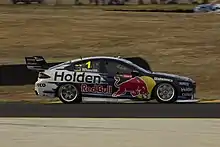
For marketing purposes, the ZB Commodore will be raced in various motorsport disciplines, however, the race cars generally have no physical or mechanical relationship with the production model, other than similar looks, as an exterior shell is built to resemble the road going cars, with a rear wheel drive tube frame chassis underneath.
Supercars Championship The ZB Commodore is used by teams running Holdens in the Supercars Championship. Powered by the same V8 engine as used in the VF, a turbo charged V6 engine was under development for use in 2019, however the project was cancelled in April 2018 amid engineering concerns that the V6 would not be competitive.[36][37]
Sales
Sales of the new Commodore commenced in February 2018. The ZB is the first Commodore produced outside of Australia since the nameplates induction in 1978, leading to much public backlash.
Consumer uptake and acceptance have been the lowest for any Commodore branded vehicle in the history of Holden manufacturing, however, this has also come at the same time as the nameplate has shifted market segment and competition, with the ZB outperforming all but the Toyota Camry in the Medium/Large segment, including the Mazda6 and Ford Mondeo.[38]
| Jan | Feb | Mar | Apr | May | Jun | Jul | Aug | Sep | Oct | Nov | Dec | Total | |
|---|---|---|---|---|---|---|---|---|---|---|---|---|---|
| 2018 | N/A | 363 | 516 | 473 | 885 | 946 | 516 | 635 | 672 | 663 | 701 | 381 | 6,751 |
| 2019 | 393 | 569 | 406 | 629 | 670 | 550 | 460 | 509 | 419 | 469 | 309 | 5,373 |
Future developments
When the decision was made to cease vehicle production in Australia and source the ZB Commodore from Europe, Opel and Vauxhall were still subsidiaries of GM. On 1 August 2017, both were sold to Groupe PSA, who announced that it will transfer the Opel Insignia platform to PSA platforms as early as 2021, which means the current model would be discontinued as PSA plans to export PSA-based Opel models globally from 2018 onwards.[39][40]
On 17 October 2018, Holden halted imports of the Commodore due to slow sales, and an increasing number of unsold cars at its dealerships.[41] On 10 December 2019, Holden announced the Commodore would be discontinued indefinitely at the end of 2020.[42]
Motorsport
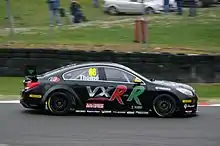
The Thorney Motorsport team first ran a Vauxhall Insignia VXR in the last round of the 2011 British Touring Car Championship to prepare a two car team for the season of 2012.[43]
Only one car was run in four rounds – 1 and 2 driven by John Thorne, and 6 and 9 driven by Tony Gilham. Tony's Team HARD bought the two Insignias from Thorney Motorsport,[44] and raced one of them himself in the last round of the 2012 season.
Driving both cars for the season of 2013 were James Cole and Jack Goff, running under the RCIB Insurance Racing team name. RCIB Insurance Racing/Team Hard sold the cars to BMR for the 2014 BTCC season, and would be driven by Jack Goff and Warren Scott. The Insignia was not as competitive as hoped and the cars were replaced mid season with Volkswagen CCs.
2003 Insignia Concept
| 2003 Insignia Concept | |
|---|---|
 | |
| Overview | |
| Manufacturer | Opel |
| Production | 2003 (Concept car) |
| Designer |
|
| Body and chassis | |
| Class | Full-size luxury car (F) |
| Body style | 5-door liftback |
| Layout | FR layout |
| Platform | Premium platform |
| Powertrain | |
| Engine | 5.7 L LS1 V8 |
| Transmission | 7-speed automatic |
| Dimensions | |
| Wheelbase | 2,915 mm (114.8 in) |
| Length | 4,803 mm (189.1 in) |
| Width | 1,914 mm (75.4 in) |
| Height | 1,414 mm (55.7 in) |
| Chronology | |
| Successor | Buick Avenir |
The Opel Insignia Concept is a full-size luxury car (F-segment in Europe) presented by the German automaker Opel at the 2003 Frankfurt Motor Show in Germany.[45][46] The car has a V8 engine from the Corvette with 344 PS (253 kW; 339 hp). The Insignia Concept has a hydropneumatic suspension system, a pantograph like mechanism for the rear sliding doors, and LED lighting technology.
In the beginning of 2005, it was announced by Opel that this concept car will not be built, because it would be too heavy and too expensive. This vehicle remained therefore a pure concept study. However, this concept car inspired the 2015 Buick Avenir and the platform was used in the Alfa Romeo 159.
 Opel Insignia Concept at the 2003 Frankfurt Motor Show
Opel Insignia Concept at the 2003 Frankfurt Motor Show Rear sliding doors
Rear sliding doors Rear view
Rear view
Notes
- For an outline of ANCAP tests, visit the ANCAP website.
References
- "New Opel Insignia: New Name for a New Era". General Motors. 29 November 2007. Archived from the original on 30 March 2008. Retrieved 2 April 2008.
- Aziz, Nick (5 November 2008). "2010 Buick Regal: Insignia-based luxury sedan for China revealed". Leftlane. Retrieved 21 August 2009.
- Aziz, Nick (20 July 2009). "Confirmed: Buick Regal coming to America in late 2010". Leftlane. Archived from the original on 5 November 2011. Retrieved 21 August 2009.
- "Multiplicación de novedades". El Mercurio (in Spanish). 18 October 2008. Retrieved 4 November 2008.
- "Opel Insignia" (in Spanish). Opel Chile. 12 January 2012. Retrieved 12 January 2012.
- Flynn, Malcolm (1 August 2012). "2013 Opel Insignia On Sale In Australia". Themotorreport.com.au. Retrieved 14 December 2013.
- Dowling, Joshua (2 August 2013). "Opel abandons Australian arm after less than a year after poor sales". News.com.au. Retrieved 14 December 2013.
- "Vauxhall to ditch Vectra name". whatcar.com. 11 December 2006. Retrieved 11 June 2015.
- "London launch for Vectra replacement?". whatcar.com. 8 March 2007. Retrieved 11 June 2015.
- "First look at Vectra replacement". whatcar.com. 4 September 2007. Retrieved 11 June 2015.
- "New Vectra launch update". whatcar.com. 12 September 2007. Retrieved 11 June 2015.
- "Goodbye Vauxhall Vectra, hello Insignia". whatcar.com. 29 November 2007. Retrieved 11 June 2015.
- "Malcolm Ward Appointed Director of Exterior Design". Theautochannel.com. 22 April 2009. Retrieved 14 December 2013.
- "Media". www.vauxhall.co.uk. Retrieved 5 March 2013.
- "London show: Vauxhall Insignia". Autocar. 22 July 2008. Retrieved 2 August 2008.
- Pettendy, Marton (16 April 2009). "First look: HSV's turbocharged Insignia mid-sizer". GoAuto. Retrieved 8 October 2009.
- Torr, Feann (9 August 2005). "Opel Vectra OPC: First Look". WebWombat. Retrieved 8 October 2009.
- Miercuri, Publicat (15 July 2009). "Cireasa de pe tort". AutoMarket (in Romanian). Retrieved 8 October 2009.
- "New Opel Insignia OPC Unlimited Edition Ditches Speed Limiter topping out at 270km/h". Carscoops. 15 April 2011. Retrieved 14 December 2013.
- "All-new Opel 2.0 CDTI: New Generation Large Diesel Debuts in Paris". Media Opel. 10 September 2014. Retrieved 14 November 2014.
- "Happy Birthday Opel Insignia – Europe's Shooting Star in 2009". bloggersbase.com. Archived from the original on 15 November 2009. Retrieved 1 May 2010.
- "Rewind to 2009: Vauxhall Insignia". Quicks. Archived from the original on 4 February 2014. Retrieved 25 February 2014.
- Tan, Paul (17 November 2008). "Vauxhall Insignia wins 2009 Car of the Year award". Retrieved 17 November 2008.
- "DEKRA Faults Report 2011: Opel Insignia Gets Top Marks for Quality". Retrieved 15 December 2010.
- "GTÜ Used Car Report – Opel Insignia is Again Number One". Retrieved 17 September 2012.
- "Ford Fiesta is top in 09". Car Dealer Magazine. 8 January 2010. Archived from the original on 21 May 2010. Retrieved 16 January 2010.
- "The 500.000th Opel Insignia Leaves The Rüsselsheim Plant". scoopcar.com. Archived from the original on 14 December 2013. Retrieved 26 April 2012.
- "Used Opel Insignia review: 2012-2013". CarsGuide. Retrieved 16 January 2019.
- https://www.caradvice.com.au/697503/holden-commodore-equinox-halted/
- https://www.caradvice.com.au/811407/holden-record-low/
- https://performancedrive.com.au/australian-vehicle-sales-for-november-2019-vfacts-0415/
- "Holden just killed the Commodore". www.autocar.co.nz. Retrieved 10 December 2019.
- "2018 Holden ZB Commodore testing reaches 100,000km milestone". WhichCar. Retrieved 6 October 2017.
- https://www.motoring.com.au/ancap-to-retest-new-holden-commodore-111256/
- https://www.goauto.com.au/news/general-news/safety/ancap-re-tests-holden-commodore/2018-05-09/72513.html
- "T8 retains V8 in phased Gen II implementation". Speedcafe. 9 June 2017.
- Holden suspends V6 turbo development Speedcafe 6 April 2018
- https://www.whichcar.com.au/news/zb-commodore-segment-success-overall-sales-decline
- https://practicalmotoring.com.au/car-news/insignia-based-all-new-commodore-gone-2021-holden/
- Pettendy, Marton (17 November 2017). "Where to for Holden and Commodore? (17 Nov 2017)". motoring.com.au. Retrieved 9 April 2018.
- "Holden Stops Commodore, Equinox Production" from GM Authority (17 October 2018)
- "Holden just killed the Commodore". www.autocar.co.nz. Retrieved 10 December 2019.
- Turner, Kevin (11 April 2011). "New BTCC team to run Insignias". Autosport. Retrieved 12 April 2011.
- Chalcraft, Jodie (16 October 2012). "Two Vauxhall Insignias for Team Hard in 2013". Btcccrazy.co.uk. Retrieved 14 December 2013.
- "Opel Insignia : Concept Cars". Diseno-art.com. Retrieved 14 December 2013.
- "Opel Insignia Concept". Supercars.net. 1 March 2004. Retrieved 27 January 2012.
External links
| Wikimedia Commons has media related to |
